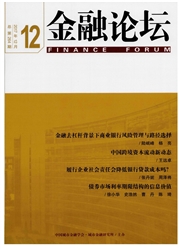

 中文摘要:
中文摘要:
本文在中国当前使用的流动性缺口管理方法的基础上,结合巴塞尔委员会《流动性风险计量、标准和监测的国际框架(征求意见稿)》(2009),给出关于流动性风险计量的改进方法。改进方法使用了高质量流动资产、净流动性缺口和净流动性缺口占总资产的比率三个指标,克服了传统流动性缺口管理没有充分考虑资产质量和资产流动性特征等缺点,更好地反映商业银行的流动性风险。通过实证分析先对国内3家银行2006-2009年年报数据进行比较,然后对国内10家银行2009年年报数据进行比较,进一步验证了改进方法的优越性。
 英文摘要:
英文摘要:
On the basis of liquidity gap management approaches used extensively in China, the paper establishes an improved approach to measuring liquidity risk according to International Framework for Liquidity Risk Measurement, Standards and Moni- toring- Cor~ultative Document(2OO9)of the Basel Committee. The improved approach uses three indicators(high quality liquid assets, net liquidity gap and net liquidity gap to total assets ratio )to overcome the defect that traditional liquidity gap manage- ment fails to fully consider asset quality and liquidity, so the improved one can reflect commercial bank's liquidity risk better. The paper first compares three domestic banks ' annual report data from 2006 to 2009 and then compares 10 domestic banks'annual report data in 2009 to further test and verify the superiority of the improved approach.
 同期刊论文项目
同期刊论文项目
 同项目期刊论文
同项目期刊论文
 期刊信息
期刊信息
